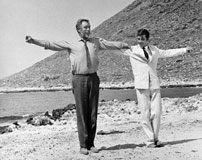|
 |
|
 |
|
 |
 |
| |
16:9 in English: Identification: a Four-phase Model
By RICHARD RASKIN
Editor’s introduction
Approximately twelve years ago I first laid eyes on a one-page handout describing identification as consisting of four phases: designation, appeal, participation and internalization (see the original table at the end of the article). The handout was written by my former teacher and now colleague, Richard Raskin, in 1983. I have always admired the clarity, explanatory potential and analytic usefulness of Raskin’s model. Naturally, the literature on the topic has expanded since 1983 - particularly as regards studies with a theoretical base in emotion and cognition studies. A canonic book on identification – or rather engagement – in the cinema was written by Murray Smith and published in 1995 (Engaging Characters). Readers familiar with Smith’s book might find some overlap with terms such as recognition, alignment (and attachment), and allegiance. Raskin carves out the matter in a slightly different fashion – but on that one piece of paper Raskin actually suggested a way of understanding character identification that was precise and brief, yet remarkably nuanced.
Introducing Raskin’s model in various courses on film analysis and media text analysis has certainly had the effect that many of my own students take up Raskin’s taxonomy when analyzing various media texts in their exam papers. However, they have found it awkward to cite an un-published handout. For this reason alone it is due time that Raskin’s thoughts on the matter are presented in proper form. Thus I have asked him to present his model in the form of an article illustrated with examples from specific films.
Jakob Isak Nielsen, editor 16:9
What follows is not an academic paper on identification, replete with references to the literature on the subject. It is based on a one-page table made nearly thirty years ago, in which I proposed viewing identification as an evolving process passing through a sequence of four successive phases. There was no model of that kind in the extensive literature I read at the time, but not having done much research on the subject since 1983, I do not know whether anyone has more recently developed a comparable view of identification. I must have used the one-page overview as a handout in 1999, when Jakob Isak Nielsen, now a distinguished colleague, was a student of mine, and it is entirely as a result of his encouragement that I will now try to flesh out that model with a few concrete examples. |
|

Fig. 1. Anthony Quinn as Alexis Zorba in Zorba the Greek (1964), directed by Michael Cacoyannis. |
|
| |
PHASE ONE: DESIGNATION
A character is designated as occupying a special status within the film and as being a potentially appropriate object of identification.
Although there are exceptions to any rule, a fiction film will generally provide – in its opening minutes or even the first few seconds – a signal to the viewer indicating whose story is being told. This is typically done by means of close shots that single out the character for prolonged attention, often but not always combined with narrative devices indicating the admiration or authority the character enjoys. Shots bringing us into the character’s p.o.v. may also be used in this connection, as in our first encounter with Rick (Humphrey Bogart) in Casablanca (1942), in which we see through his eyes as he okays a check before we see his face (fig. 2).
Often and for obvious reasons, this tagging of the film’s main character also designates the film’s primary object of identification. But the situation is sometimes more complex, for example when the main character undergoes a transformation inspired by another character, as in Zorba the Greek, in which Basil (Alan Bates) learns from Alexis Zorba (Anthony Quinn) how to live his life more fully. Here, Zorba is as much an object for our identification as is Basil, and in the early scene in which Zorba first appears in the film, he is clearly designated as occupying a special status in the film through such means as: a) the shot framing his rugged and searching face in the window-pane of the waiting-room door, when Basil inexplicably senses his presence and turns to look at him; b) the five or six close-ups given to Anthony Quinn, who was clearly allowed to steal the scene for his character with Cacoyannis’ full approval; and c) Basil’s utter fascination with Zorba from the moment he first lays eyes on him.
PHASE TWO: APPEAL
The character is endowed with qualities capable of fascinating or arousing the sympathy of the viewer.
Zorba’s infectious passion for living life to the fullest, even when his overriding love of life and freedom borders on the irrational, is made irresistibly appealing to the viewer, and such pithy bits of dialogue as this one clearly make their mark:
Zorba: Damn it boss, I like you too much not to say it. You've got everything except one thing: madness! A man needs a little madness, or else...
Basil: Or else?
Zorba: ...he never dares cut the rope and be free.
A character’s embodiment of a striking cluster of values or of attractive or sympathetic qualities is usually a prerequisite for the viewer’s identification with him or her. In a sense, it is actually the values or qualities with which the viewer connects. Student filmmakers often assume incorrectly that identification will take place even if the character designated for that status has not somehow earned or deserved the identification by virtue of the values he or she embodies when interacting with other characters.
PHASE THREE: PARTICIPATION
Participation can take two distinct but related forms: a) empathic or projective, which involves putting oneself in the character’s position and feeling what the character is presumed to be experiencing; and b) volitional, by which I mean wanting – from one’s own position – the character to obtain the object of his or her desire, to survive threats, to live up to his or her highest potential. |
|

Fig. 2. In Casablanca (1942) we see Rick signing a check before we see his face. |
|
| |
The first of these forms, through which the viewer vicariously experiences what the character feels, is one of the rewards of identification when things go well for the designated character. When at the end of Zorba the Greek, Zorba triumphantly teaches Basil how to dance – the film’s metaphor for living joyously in the body – we are there too on the beach, experiencing that event through our identification with both characters (fig. 3). And when in Casablanca, Rick kisses Ilsa Lund (Ingrid Bergman), male viewers are there in Bogart’s lips. (The gender issue raised here is something I couldn’t even begin to address.) And when Rick shoots Colonel Strasser (Conrad Veidt) in the final airport scene of Casablanca and Captain Renault (Claude Rains) unexpectedly lets Rick off the hook by instructing his men to “round up the usual suspects,” we experience Rick’s relief as our own. By the same token, of course, when the character with whom we identify is hurt, loses a battle, fails to live up to his or her potential, or gives up a cherished object of desire – as Rick does when he arranges for the love of his life, Ilsa Lund, to leave Casablanca with her husband, Victor Laszlo (Paul Henreid) – we vicariously experience the character’s pain or loss.
The volitional form of participation involves rooting for the character with whom we identify – our wanting him or her to succeed. In the Casablanca airport scene mentioned above, for example, we want Bogart’s character to get away with killing Strasser, and we also experience his relief when he does so. Clearly these two processes – the volitional and the vicarious – are closely related, but they are not identical. Whether anything significant is to be gained by making this hair fine distinction, I do not know.
PHASE FOUR: INTERNALIZATION
Adopting the values, outlook or behavior of the character, taken as a role-model. Wishing to be like the character and to be perceived as being like the character. |
|

Fig. 3. Zorba teaches Basil how to dance in Zorba the Greek. |
|
| |
Whether in the afterglow of experiencing a film or a good bit later, the viewer may strive to integrate into his or her own behavior or appearance, qualities of the character with whom he or she identified while watching the film. This final phase of identification is the only one that takes place after the viewing of the film is over. Countless viewers have wished to make a part of themselves some of Zorba’s unbridled love of life, and when circumstances permit, perhaps even going so far as to imitate his way of dancing, in an outward show of taking him as a role-model. Similarly, countless fans of Casablanca, and not just Woody Allen, have somehow found an occasion to say – jokingly, but nevertheless momentarily slipping into the role of Bogart’s Rick: “We’ll always have Paris” or “This is the beginning of a beautiful friendship.” (fig. 4).
There are films that can enrich and even change our lives, and when that happens, it is usually through our internalization of the values represented by a character with whom we have chosen to identify. |
|

Fig. 4. The over-the-shoulder shot favors Rick as he utters the legendary words: ”We’ll always have Paris.” |
|
| |
The original table (1983)
| DESIGNATION |
APPEAL |
PARTICIPATION |
INTERNALIZATION |
| A character is designated as occupying a special status within the film, as being an appropriate object of identification. |
The character is endowed with qualities capable of fascinating or arousing the sympathy of the viewer. |
EMPATHIC, PROJECTIVE:
Putting oneself in the character’s position and feeling what the character is presumed to be experiencing
VOLITIONAL:
Wanting – from one’s own position – the character to obtain the object of his or her desire, to survive threats, to live up to his or her highest potential |
Adopting the values, outlook or behavior of the character, taken as a role-model
Wishing to be like the character and to be perceived as being like the character |
|
|
| |
|
|
|
|
| |
|
|
|
|
| |
Editor’s post-script
In closing, I would like to add that my own perspective on the topic is not completely identical to that suggested by Raskin. First - on par with Murray Smith - I prefer to use the term engagement and reserve identification to describe a particular form of engagement. Second, in my own writing as well as in my own teaching I have suggested a few minor alterations to the model. In an article on comedy theory and There’s Something About Mary (1998), I have suggested that there can be projective participation without emphatic participation (we can imagine what it must be like for a character to be in a particular situation without necessarily sharing said character’s emotional responses).
When using the handout in my own teaching I have also found it useful to consider moving through the phases successively a likely route. One of the benefits of arguing that one does not have to move through one phase to arrive at another is that it accommodates contradictory impulses involved in character engagement. For instance we may find ourselves wanting Brandon (John Dall) and Phillip (Farley Granger) to successfully conceal their murder from Rupert (James Stewart) in Hitchcock’s Rope (1948) (volitional participation) although neither character appeals to us.
Nevertheless, these reservations are minor and solely represent my own ‘take’ on Raskin’s work. If anything they suggest that Raskin’s model continues to stimulate discussions on the topic. Hopefully, new readers will find Raskin’s thoughts on identification equally useful and thought-provoking. |
|
|
|
 |
 |
 |
 |
 |
|
 |
 |
 |
| |
Facts
Films cited
Cacoyannis, Michael (1964). Zorba the Greek, based on the novel by Nikos Kazantzakis, screenplay by Michael Cacoyannis.
Curtiz, Michael (1942). Casablanca, based on a play by Murray Burnett and Joan Alison, screenplay by Julius J. Epstein, Philip G. Epstein and Howard Koch.
Forman, Milos (1975). One Flew Over the Cuckoo’s Nest, based on the novel by Ken Kesey, screenplay by Laurence Hauben and Bo Goldman. |
|
|
|
|
 |
 |
 |
 |
16:9 - april 2011 - 9. årgang - nummer 41
Udgives med støtte fra Det Danske Filminstitut samt Kulturministeriets bevilling til almenkulturelle tidsskrifter.
ISSN: 1603-5194. Copyright © 2002-11. Alle rettigheder reserveret. |
11 |
|
|
 |
 |
|
|